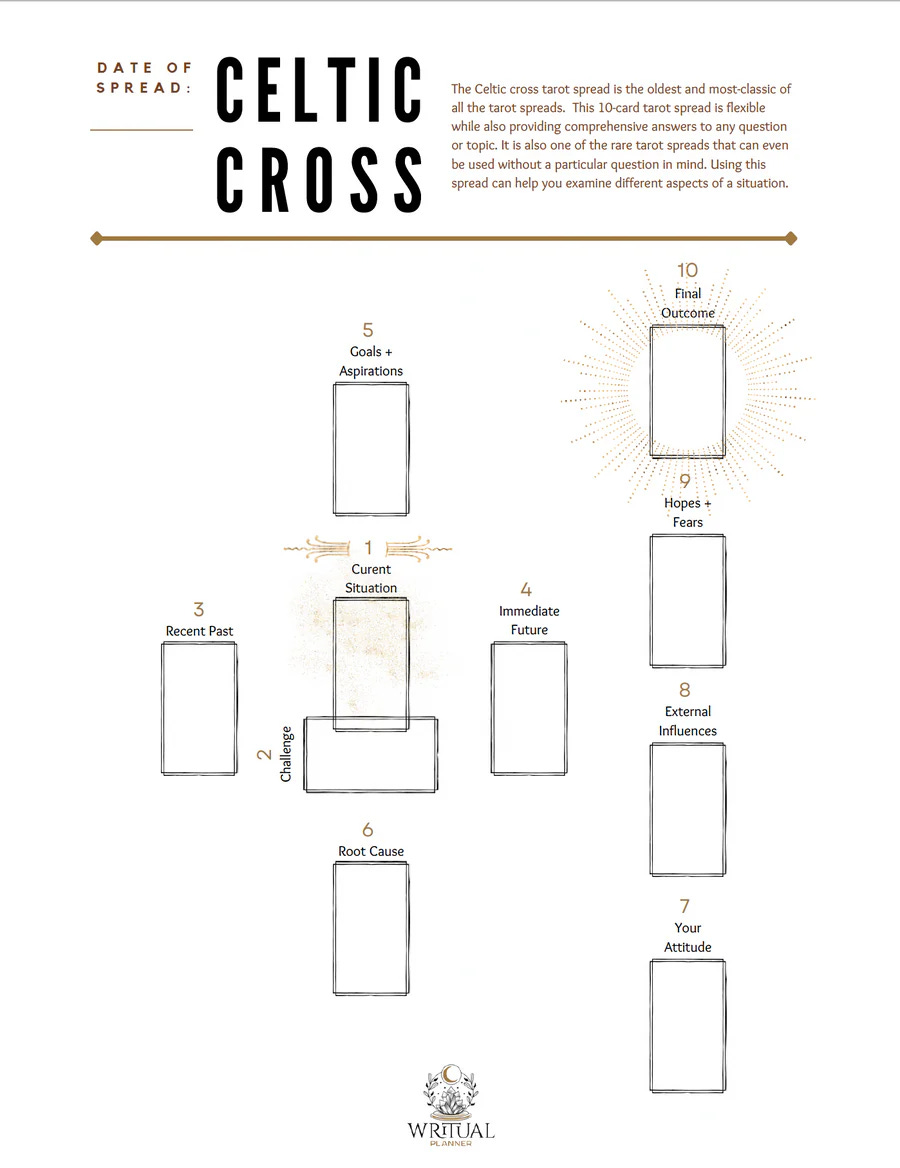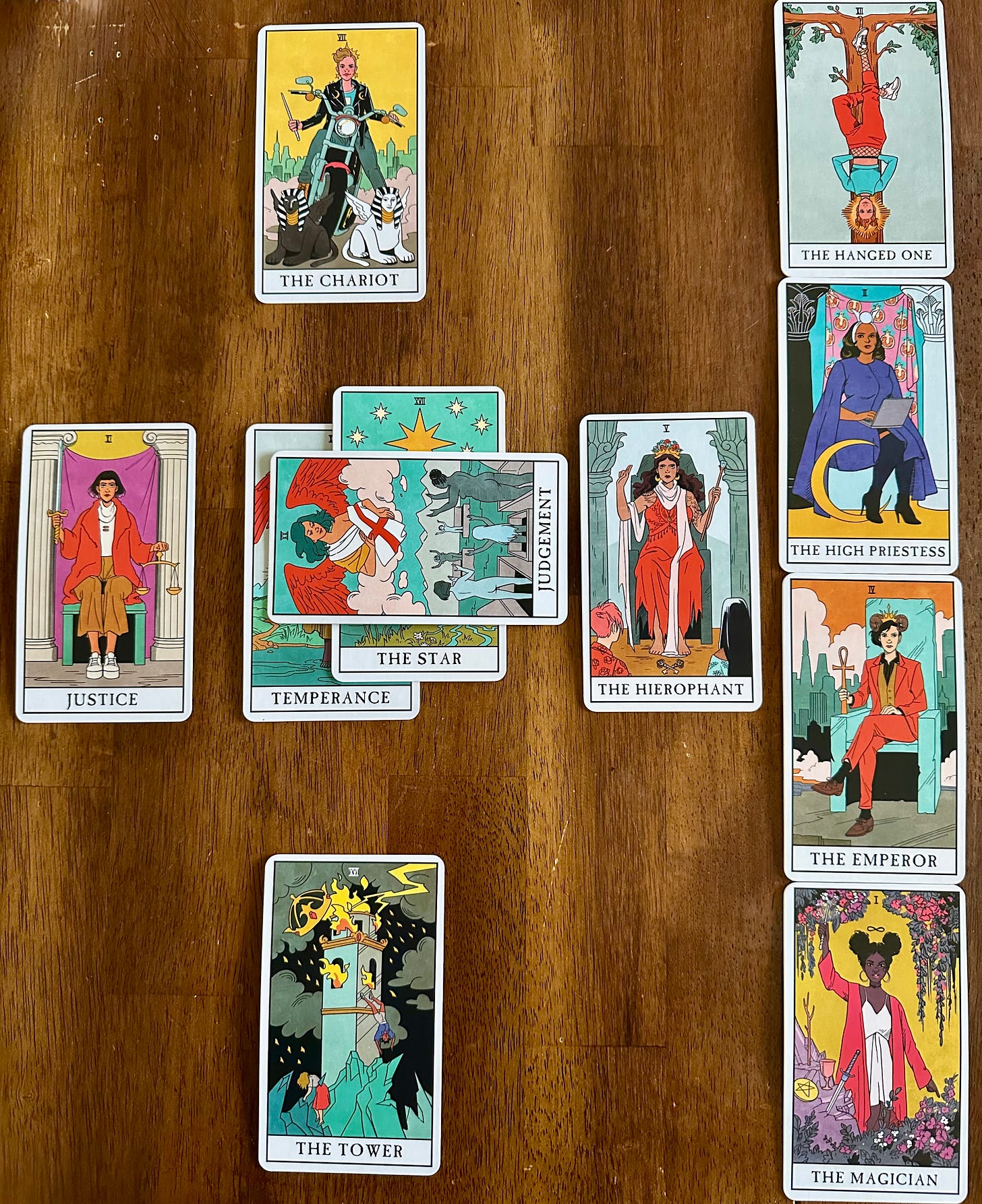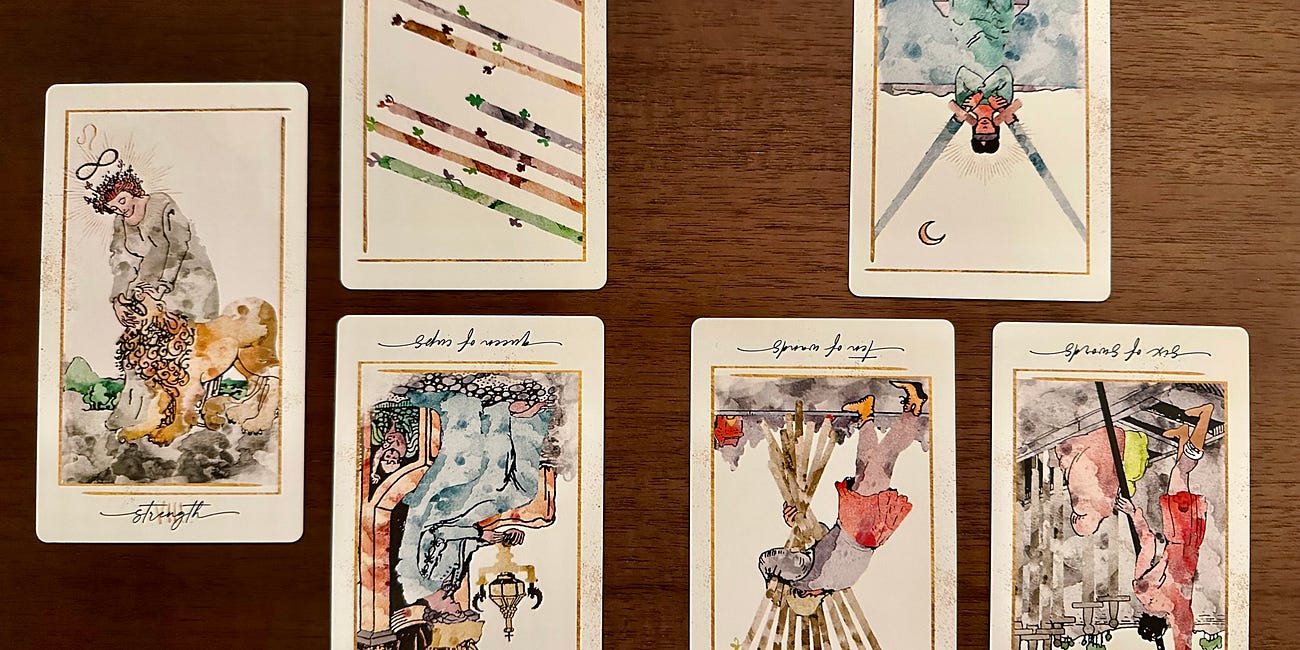Advanced Tarot Techniques, Part 2 - The Celtic Cross Leveled Up
My Bastardized Celtic Cross Spread x Hybrid Double Deck Method
My adaption on the traditional 10-card Celtic Cross spread has evolved over the years. I cannot directly trace why my 10-card spread became what it became, but it is what it is. 25 years of using the cards will do that – you find what works and stick with it. However, since starting The Experimental Intuitive, I have come to thinking how I can improve my spread using some of the methods I have written about in the past.
I read reversals. Yes, I know what some readers think of this. And you know what? To each their own. However, something shifted in my practice late last year and has been simmering ever since. For reference, and because I love the Writual Tarot Planner, this is one of the many variants of the traditional Celtic Cross spread:
What I am currently thinking about adapting the 10-card Celtic Cross spread with a method similar to double deck readings. This method pulls two cards for each position, from two different decks. However, I would like to do this a little different. Each position will have two cards, from the same deck:
One major arcana, flipping if it is drawn reversed, at each position
One second card to be drawn at each position of just pips (minor arcana) which may retain reversals should it be drawn as such.
Both stacks are from the same deck (or not!!). Why not use two favorite decks for this? For this lesson, I will use a 2nd deck simply for contrast.
Before I dive into my hybrid double deck method, I would like to share my bastardized Celtic Cross spread.
The Querent (the person I am reading for). I generally pull the top card for them, although some readers ask the Querent to select a card which calls to them out of the stack. Both are valid and common practices.
This is placed on top of the Querent card, and represents part of the situation at hand
This is placed sideways over card 2 and represents the other part of the situation at hand – perhaps a conflict. It creates a cross over the Querent card.
Above the Querent card, this is the current mindset of the Querent.
Below the Querent card, this is the distant past of the Querent, the foundation of their life today.
To the left of the Querent card, this is the recent past and will be coming to pass or already has.
To the right of the Querent card, the near future, which could come to pass.
The bottom card of the vertical row, this is the Querent’s inner world. Specifically, when faced with obstacles how do they cope?
Stacking up the row, this card is the Querent’s external environment. It represents the influence of outside people and situations.
Stacking up the row again, this card is the Querent’s heart’s desire. Deep inside, what they truly want.
The top of the vertical row, and it is the overall conclusion of the reading.
Different than the traditional, but only in a few positions. I really don’t know how this evolved, but here we are. Shaking this up, let’s see what we can do to this spread using a double deck method.
The Hybrid Double Deck Celtic Cross Spread
Prepare your deck by separating out the major arcana from the pips (minor arcana). Shuffle both stacks sufficiently. My practice is the cut each deck into three stack and ask the Querent which one they want on top. I stack that on top with the other two below.
Build the spread’s first set of cards by using only the major arcana stack at each position. Leave a little room to place a second card next to each position. If a card is drawn reversed, please flip it right-side up.
Next, pick up the pips stack and draw cards in the same order as the major arcana spread. That includes the Querent and crossed cards. You can place this group to the side if you don’t have room within the spread, just make sure it is drawn the same way. If a card is drawn reversed, it is appropriate.
We now have a complete spread, and a decent spread of cards to read. There’s a system to this, and I will break down what we just built.
The first round of major arcana cards represents the dominant energy/archetype of that position.
It is not reversed because the second set of cards will reveal if there is a reversal of energy.
When you look at how they are paired, the pips reveal either light or shadow elements underneath that major energy.
Not every card reversed is “negative”, and not every right-side up card is “positive”.
Read the pip in conjunction with a major arcana card helps to show the Querent what energies are flowing beneath the surface. Don’t go strictly by the book on the card meanings - try to use your intuition to see what the overall story of each pair tells you.
As each pair is revealed to the Querent, a larger story emerges. Are there elements linking the cards together, such as faces looking at or away from one another? Are there swords or wands pointing a particular direction or to other card positions? These are all hints to what the story has to say.
I do pull additional cards at the end: 3 for the overall conclusion card, and 3 for the near future. Use whatever stack feels right. I then ask the Querent if there are any other cards they would like to expand or discuss to close out our discussion.
I use my intuition with my guides on this part especially, and they tell me how many cards are appropriate to pull for expanding cards, how to link them together, and when the reading is done. You don’t need to be an “intuitive” to do this, just do what feels right for the reading.
As tarot practitioners, telling the story of the in the cards in an interconnected way helps the Querent identify with perspectives, emotions, and circumstances with clear coherence. As the story unfolds a productive dialogue is underway, creating a meaningful energetic connection in the process. For those who read energy and work with guides (me!), this connection is critical to deliver a reading that resonates with the Querent.
Note: This is advanced tarot work, and I did not review each card pair meaning in this post. I really want to allow practitioners the space to find their own way through the spread, in their unique style. I will address tarot pairs in a more direct way in future posts about elemental dignities and court card elemental correspondences.
Catch up!
Advanced Tarot Techniques, Part 1 - Elemental Tarot Spreads
Before we begin this lesson in tarot elemental correspondences, I would like to extend a very warm welcome to my new subscribers and followers. I truly appreciate all of you for joining my circle. Blessed Be.
Advanced Tarot Techniques, Part 3 - Elemental Dignities
Today’s advanced tarot technique lesson covers the concept of elemental dignities.
Advanced Tarot Techniques, Part 4 - Court Cards
Today’s advanced tarot lesson continues our exploration of elements. Jenna Newell Hiott from Spirit Connections will be offering her expertise in today’s post.
If you need a primer on reading reversals and linking cards by their illustrations and positions, this is for you:
Using Tarot for Writing Stories, Part 5
The contentious issue of reading versus not reading tarot card reversals is one of confusion and frustration for many readers. You will hear very specific opinions (for or against) on whether reversals are natural in the act of reading a spread. This post is a challenge to this issue to help the blocked creative. We are going to purposely turn these car…
I love comments!
Did you try this spread? How did it go for you?
Are there any future topics you’d like to see in this series?












I love the way you’ve shown the evolution of your craft. I feel tarot is a very personal journey. No one should read tarot the same. Every one of our guides influences us to read a certain way. For myself, I don’t use “spreads” that you normally see but rather an unfolding of cards that as you say “tell a story”. That story is always unfolding. I appreciate seeing how others work with and incorporate spreads in their readings. It’s inspiring so thank you. 🙏